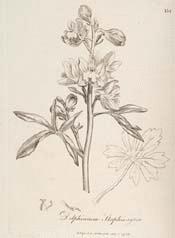

|
Stavesacre
(Delphinium staphisagria printed as
Delphinium Staphisagria)
|
Stavesacre
POISON!
Botanical: Delphinium staphisagria (LINN.)
Family: N.O. Ranunculaceae
---Synonym---Lousewort.
---Part Used---Seeds.
---Habitat---Asia Minor and Europe.
Stavesacre is a species of Larkspur, a stout, erect herb attaining 4 feet in height, indigenous to Asia Minor and southern Europe. It is cultivated in France and Italy, our supplies having before the War been drawn chiefly from Trieste and from the south of Italy.
Stavesacre was well known to both the Greeks and Romans. Dioscorides mentions it, and Pliny describes its use as a parasiticide. It continued to be extensively employed throughout the Middle Ages.
This Delphinium is an annual, with a hairy stem and hairy palmate leaves, composed of five to seven oblong lobes, which have frequently one or two acute indentures on their sides. The flowers form a loose spike at the upper part of the stalk, each on a short peduncle, and are of a pale-blue or purple colour.
[Top]
---Cultivation---The seeds of this species should be sown in April, where the plants are intended to remain and require no special treatment, growing in almost any soil or situation, but the plants are most luxuriant when given a deep, yellow loam, well enriched with rotted manure and fairly moist. They should be thinned to a distance of 2 feet apart.
---Part Used---The dried, ripe seeds. Shake the seeds out of the pods on trays and spread them out to dry in the sun. Then pack away in airtight boxes or tins. The dried, ripe seeds are brown when fresh, changing to a dull, earthy colour on keeping. In shape they are irregularly quadrangular, one side being curved and larger than the others, and the surface of the seed is wrinkled and pitted. They average about 6 mm. (nearly 1/4 inch) long and rather less in width, ten weighing about 6 grains. The seed coat is nearly tasteless, but the endosperm is oily and has a bitter and acrid taste. The seeds have no marked collour.
---Constituents---The chief constituents of Stavesacre seeds are from 20 to 25 per cent of alkaloidal matter, which consists chiefly of the bitter, acrid, crystalline, alkaloid Delphinine, an irritant poison, and a second crystalline alkaloid named Delphisine, and the amorphous alkaloid Delphinoidine. Less important are staphisagroine, of which traces only are present, and staphisagrine, which appears to be a mixture of the first three elements.
[Top]
---Medicinal Action and Uses---Vermifuge and vermin-destroying. Stavesacre seeds are extremely poisonous and are only used as a parasiticide to kill pediculi, chiefly in the form of the official ointment, the expressed oil, the powdered seeds, or an acid aqueous extract containing the alkaloids.
These seeds are so violently emetic and cathartic that they are rarely given internally, though the powdered seeds have been given as a purge for dropsy, in very small quantities at first and increased till the effect is produced. The dose at first should not exceed 2 or 3 grains, given in powder or decoction, but the administration of the drug must always be accompanied by great caution, as staphisagrine paralyses the motor nerves like curare.
The seeds are used as an external application to some cutaneous eruptions, the decoction, applied with a linen rag, being effectual in curing the itch. It is made by boiling the seeds in water.
Delphinine has also been employed similarly to aconite, both internally and externally, for neuralgia. It resembles aconite in causing slowness of pulse and respiration, paralysis of the spinal cord and death from asphyxia. By depressing the action of the spinal cord it arrests the convulsions caused by strychnine.
See:
ACONITE
LARKSPUR (FIELD)
[Top]
Common Name Index
A MODERN HERBAL Home Page
Bear in mind "A Modern Herbal" was written with the conventional wisdom of the early 1900's. This should be taken into account as some of the information may now be considered inaccurate, or not in accordance with modern medicine.
© Copyright Protected 1995-2004 botanical.com

|

